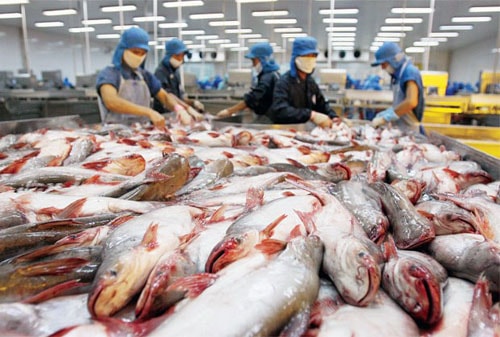New 'noose' threatens Vietnamese pangasius
Many Vietnamese businesses are worried that tra fish exports to this market will decrease sharply in the coming time due to stricter inspections under the supervision of the US Department of Agriculture.
Recently, the US Department of Agriculture (FSIS) officially announced the decision to implement the Catfish Inspection Program for imported Pangasius into the US. This regulation will take effect from March 2016.
Accordingly, from March 2016, all fish species of the Siluriformes family, including catfish and pangasius in Vietnam will be under the supervision of FSIS and will no longer be regulated by the US Food and Drug Administration (FDA) as before. From now on, the entire strict control process will be implemented according to the requirements of the 2014 Agricultural Law.
 |
| Vietnamese pangasius is at risk of facing many difficulties in the coming time in the US. Photo: MH. |
During the 18-month transition period, FSIS will conduct re-inspection and random sampling at least quarterly at U.S. import establishments to determine the species and residues in imported Siluriformes fish shipments. During this transition period, countries that wish to continue exporting these products to the United States after the transition period are required to submit applications for equivalence. FSIS will assist countries in submitting applications for equivalence.
Countries that submit complete equivalence documentation within the 18-month time limit will be allowed to continue exporting to the United States while FSIS conducts a full review, including on-site inspections of the country’s farm and production sites. If additional information is needed, FSIS will request that the country respond or resubmit complete equivalence documentation within 90 days of FSIS’s request.
Thus, with this new regulation, according to the Vietnam Association of Seafood Exporters and Producers (VASEP), in the coming time, many Vietnamese tra fish businesses will have difficulty entering the US market.
Talking to VnExpress.net, Mr. Truong Dinh Hoe, General Secretary of VASEP said that supervision is not only at the enterprise level but FSIS also controls the chain from breeds, food, transportation, farming, processing and import and export. This will cause difficulties for each individual in the chain.
He gave an example, assuming Vietnam does not have a good management program, if a link in the chain has a problem, Vietnamese goods will not be allowed to enter the US. In particular, in the near future, when the monitoring system changes, the US control programs will also change. Currently, Vietnam still does not have specific information about how strict the US will be in its regulations on Vietnamese exports. Therefore, the most important thing is that Vietnam must be recognized as being similar to the US monitoring regulations to have the opportunity to enter this market.
Also showing some concern, Mr. Tran Van Quang, Director of Southern Seafood Industry Company Limited, is concerned that export products will decrease sharply. According to him, the US Department of Agriculture is even more strict than the FDA.
“In the past two years, our tra fish export output to this market has decreased by 20-40% because the product is subject to very high anti-dumping tax. In the coming time, if this market introduces more stringent monitoring procedures, the export volume will continue to decrease,” Mr. Quang said, adding that he only learned the information this week, so businesses and management agencies are also meeting to study and discuss solutions.
At the tra fish exporting enterprise in Dong Thap, the leader of this unit said that they are reviewing the product chain from farming to processing.
“In the beginning when the regulation comes into effect, we will certainly suffer losses. However, if we can create similarities in business management, it will create more competition in this market because the market is filtered,” said a business representative.
Statistics from VASEP show that in the first 10 months of the year, tra fish exports decreased sharply compared to the same period in 2014. In particular, the two major markets, Europe and the US, both decreased when exports to the US reached over 260 million USD, down 4.6% and exports to the EU reached nearly 246 million USD, down 15% compared to the same period.
According to Mr. Hoe, with the above challenges, Vietnamese businesses should carefully analyze and review these new regulations to see how well they can meet them.
"In fact, Vietnamese products have been exported to many countries, including demanding markets like Europe. Regarding this new regulation, many opinions say that it is not standard and not consistent with WTO commitments. Therefore, Vietnam may pursue to resolve the dispute. From there, Vietnamese enterprises will have fairness when entering demanding markets," Mr. Hoe added.
According to VNE
| RELATED NEWS |
|---|

